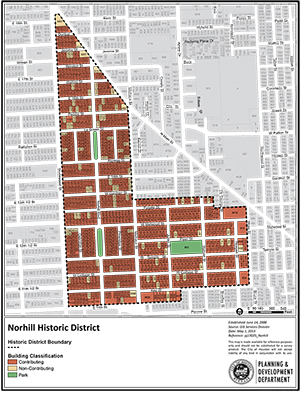

Norhill
About
The Norhill subdivision north of downtown was a planned community for working-class families. Houston businessman Will Hogg developed the neighborhood in the 1920s. Most of the houses in the neighborhood are Craftsman bungalows. The Norhill Historic District includes two of the three sections of the original neighborhood. The North and East sections (located north of 11th Street) are inside the district boundaries, while the South section (south of 11th) is not included.
By the end of Worldw War I, Houston had one of the strongest economies in the South. It was a railroad center and a shipping center, thanks to the Houston Ship Channel and Port of Houston. The city’s population boomed between 1900 and 1925. New residential developments sprang up all over Houston to meet the demand for housing. No one played a more important role in meeting that demand than William C. “Will” Hogg.
Will Hogg was a member of one of Texas’ most wealthy and influential families. In 1920, Hogg organized a group to develop a master planned community for working-class families, Norhill. Norhill was built with streets, curbs, sidewalks, and water and sewer lines. Norhill Boulevard was the main thoroughfare in North Norhill; it runs the entire length of the neighborhood. The boulevard contains esplanades that provided green space and a park-like quality to the neighborhood.
The developers also planned space for schools, parks, and commercial activity. Norhill’s commercial center was located along 11th Street, between Studewood and Pecore Streets. That commercial corridor separated North and East Norhill from South Norhill. Proctor Plaza Park is located in the East Norhill area. Adding to the sense of family, several churches also moved to the neighborhood.
Norhill was only a short ride from downtown by the existing Studewood streetcar line or automobile and the entire Norhill subdivision developed very quickly. Lots sold for between $650 and $1,000. Buyers could make a 2% down payment, then pay 2% per month at 7% interest. The lots started selling in 1923. By August 1924, more than 700 lots had been sold and many homes had already been constructed.
Deed restrictions were established to protect the value of the neighborhood. Specifically, they required that all houses cost at least three times as much as the lot on which they were built; that the homes be set back from the street by a certain distance, and no garages could be used for living quarters. On lots surrounding Proctor Plaza, there were additional requirements for the homes to have brick veneer on the exterior.
Over time, Norhill experienced the same ups and downs as other historic neighborhoods. Today, Norhill attracts educated professionals who want to live in an established community. The Norhill Neighborhood Association is a group of residents who work to make the Norhill area a better place to live.